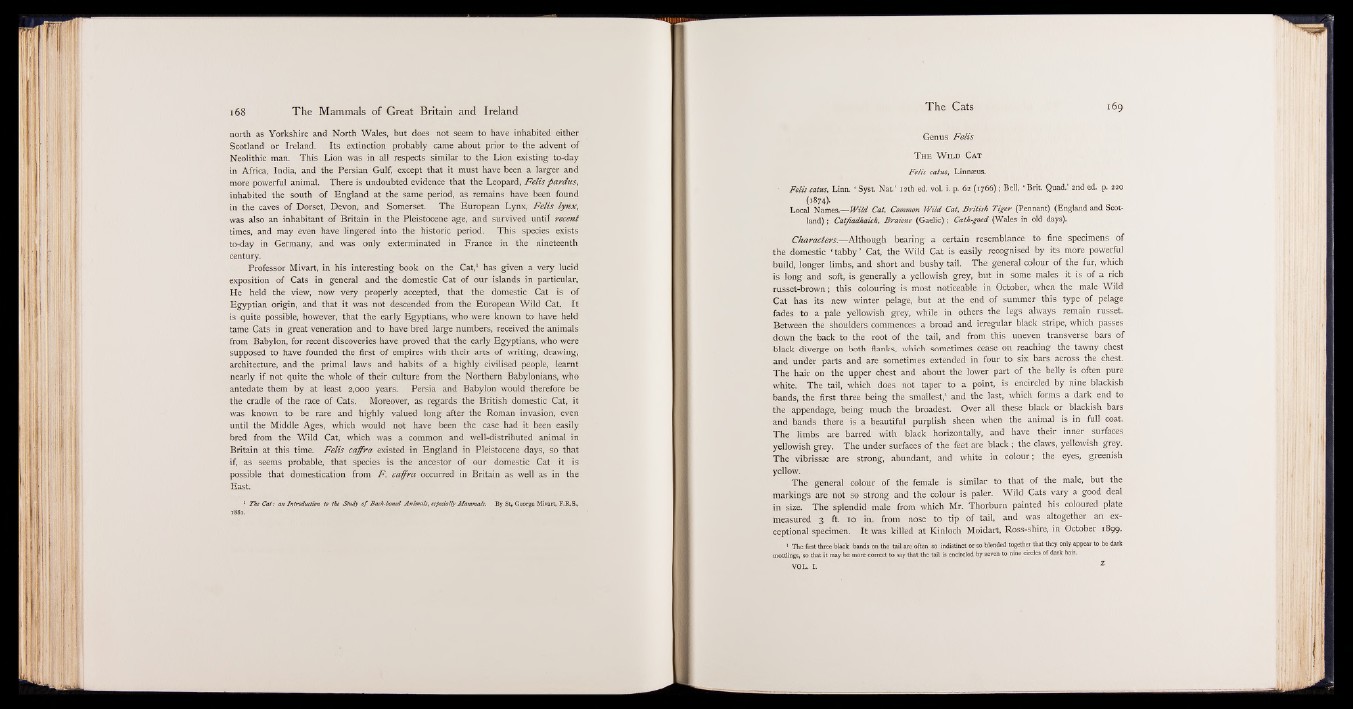
north as Yorkshire and North Wales, but does not seem to have inhabited either
Scotland or Ireland. Its extinction probably came about prior to the advent of
Neolithic man. This Lion was in all respects similar to the Lion existing to-day
in Africa, India, and the Persian Gulf, except that it must have been a larger and
more powerful animal. There is undoubted evidence that the Leopard, F elts pardus,
inhabited the south of England at the same period, as remains have been found
in the caves of Dorset, Devon, and Somerset.. The European Lynx, F elis lynx,
was also an inhabitant of Britain in the Pleistocene age, and survived until recent
times, and may even have lingered into the historic period. This species exists
to-day in Germany, and was only exterminated in France in the nineteenth
century.
Professor Mivart, in his interesting book on the Cat,1 has given a very lucid
exposition of Cats in general and the domestic Cat of our islands in particular.
He held the view, now very properly accepted, that the domestic Cat is of
Egyptian origin, and that it was not descended from the European Wild Cat. It
is quite possible, however, that the early Egyptians, who were known to have held
tame Cats in great veneration and to have bred large numbers, received the animals
from Babylon, for recent discoveries have proved that the early Egyptians, who were
supposed to have founded the first of empires with their arts of writing, drawing,
architecture, and the primal laws and habits of a highly civilised people, learnt
nearly if not quite the whole of their culture from the Northern Babylonians, who
antedate them by at least 2,000 years. Persia and Babylon would therefore be
the cradle of the race of Cats. Moreover, as regards the British domestic Cat, it
was known to be rare and highly valued long after the Roman invasion, even
until the Middle Ages, which would not have been the case had it been easily
bred from the Wild Cat, which was a common and well-distributed animal in
Britain at this time. F elis caffra existed in England in Pleistocene days, so that
if, as seems probable, that species is the ancestor of our domestic Cat it is
possible that domestication from F . caffra occurred in Britain as well as in the
East.
1 The Cat: an Introduction to the Study o f Back-boned Animals, especially Mammals. By St, George Mivart, F.R.S.,
1881.
Genus F elis
T h e W i l d C a t
F elis catus, Linnaeus.
F elis catus, Linn. ‘ S y s t Nat.’ 12th ed. vol. i. p. 62 (1766); Bell, ‘ Brit. Quad.’ 2nd ed. p. 220
(1874).
Local Names.— W ild Cat, Common W ild Cat, British T iger (Pennant) (England and Scotland)
; Catfiadhaich, Braiene (Gaelic); Cath-goed (Wales in old days).
Characters.— Although bearing a certain resemblance to fine specimens of
the domestic ‘ tabby ’ Cat, the Wild Cat is easily recognised by its more powerful
build, longer limbs, and short and bushy tail. The general colour of the fur, which
is long and soft, is generally a yellowish grey, but in some males it is of a rich
russet-brown; this colouring is most noticeable in October, when the male Wild
Cat has its new winter pelage, but at the end of summer this type of pelage
fades to a pale yellowish grey, while in others the legs always remain russet.
Between the shoulders commences a broad and irregular black stripe, which passes
down the back to the root of the tail, and from this uneven transverse bars of
black diverge on both flanks, which sometimes cease on reaching the tawny chest
and under parts and are sometimes extended in four to six bars across the chest.
The hair on the upper chest and about the lower part of the belly is often pure
white. The tail, which does not taper to a point, is encircled by nine blackish
bands, the first three being the smallest,1 and the last, which forms a dark end to
the appendage, being much the broadest. Over all these black or blackish bars
and bands there is a beautiful purplish sheen when the animal is in full coat.
The limbs are barred with black horizontally, and have their inner surfaces
yellowish grey. The under surfaces of the feet are black; the claws, yellowish grey.
The vibrissae are strong, abundant, and white in colour; the eyes, greenish
yellow.
The general colour of the female is similar to that of the male, but the
markings are not so strong and the colour is paler. Wild Cats vary a good deal
in size. The splendid male from which Mr. Thorburn painted his coloured plate
hieasured 3 ft. 10 in. from nose to tip of tail, and was altogether an exceptional
specimen. It was killed at Kinloch Moidart, Ross-shire, in October 1899.
1 The first three black bands on the tail are often so indistinct or so blended together that they only appear to be dark
mottlings, so that it may be more correct to say that the tail is encircled by seven to nine circles of dark hair.
VOL. I.